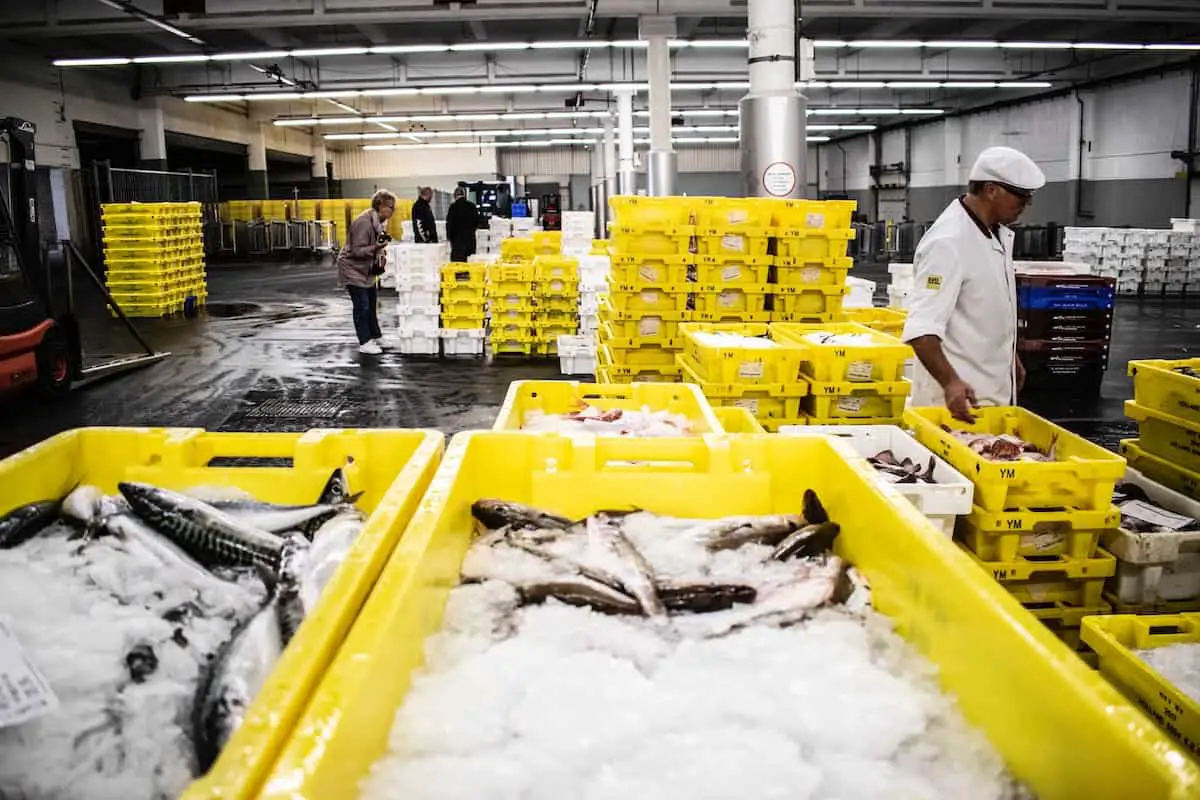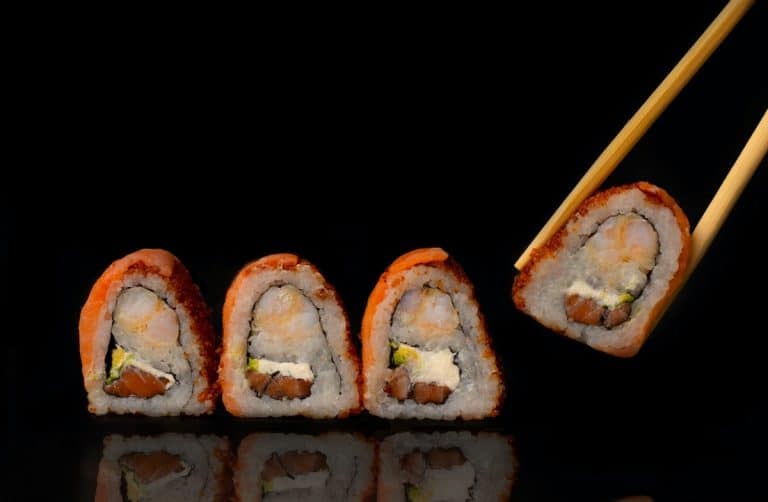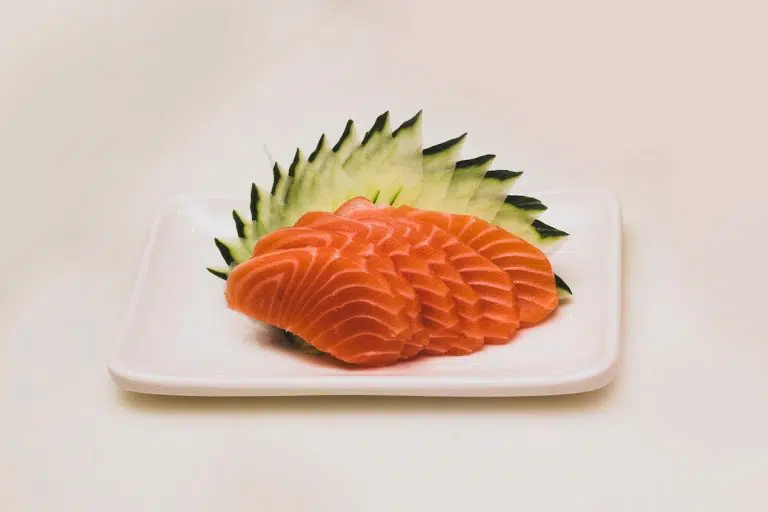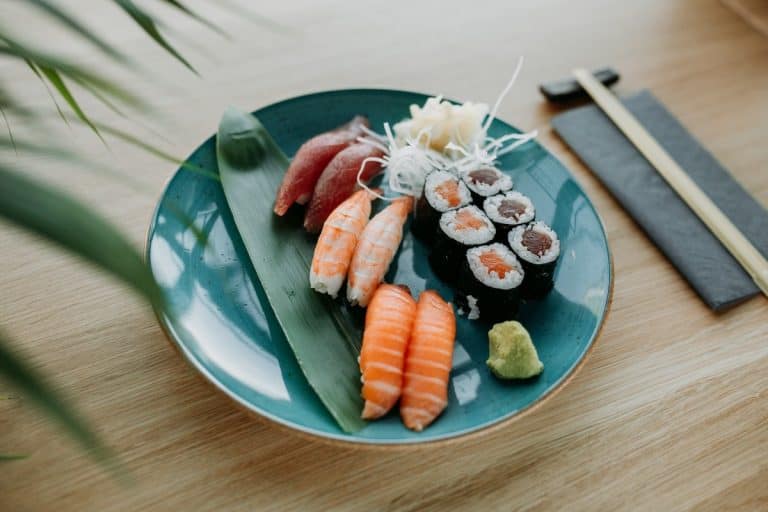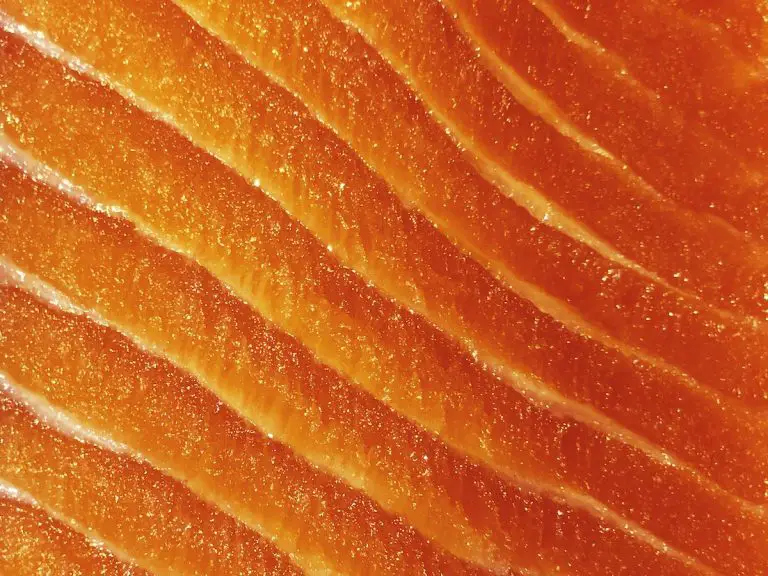I recently had the pleasure of being interviewed by a team from CNN on sustainability issues in the sushi industry. I explained what I call the “four S rule” – a simple, if somewhat crude, guide to eating in a more sustainable fashion at the sushi bar.
As I discuss in the video, there are four adjectives, each starting with the letter S, that form the eponymous rule. If a sushi bar patron bears these descriptors in mind while he or she orders, it can markedly diminish the environmental footprint created by dinner. This is not a perfect system – there are exceptions to each of the four “S” words – but by and large, it does help one to order a more sustainable sushi meal overall.
Skipjack tuna served nigiri-style with gobo, scallions, and a shiso leaf. The skipjack is the smallest tuna found in the sushi industry, and has both the lowest average mercury content and the highest reproduction rate.
Small
The first word is SMALL. Smaller fish are generally lower on the trophic scale (food chain), grow more quickly, die younger, and breed in larger numbers. These biological survival tactics are employed by many fish to help them withstand heavy predation — they play the numbers game and simply create as many offspring as possible so a few manage to escape the yawning maws of hungry predators. In essence, these are the kind of fish that are designed to be fed upon. Their physiology and population dynamics are generally more resilient to our fishing pressure and protein demand than top-of-the-food-chain carnivores, such as large tunas, swordfish, and sharks. Moreover, smaller fish generally have less mercury accumulation in their systems than these apex predators due to their shorter life spans and less voracious appetites.
Examples: Sardines (iwashi), skipjack tuna (katsuo), horse mackerel (aji)
Wild coho salmon, sashimi-style. Alaskan coho is well managed, healthy for consumers, and seasonally available.
Seasonal
The next word is SEASONAL. Seasonality is key to sustainability. If we are to reduce our carbon dependency and rekindle our connection with the ocean, we need to be more aware of where we are and what time of year it is when we order our fish. A good rule of thumb is to order off the specials board rather than the laminated menu when possible – any items on a year-round menu are unlikely to be sourced on a basis of seasonal awareness. It was our demand that certain intrinsically seasonal products be available to us year-round that gave rise to environmental missteps like conventional salmon farming. This category also offers us the added opportunity to take advantage of seasonal vegetables and fruits, which innovative chefs often incorporate into their specials.
Examples: Wild salmon (sake), Dungeness crab (kani), spot prawns (ama ebi),
Pacific saury prepared over wood charcoal. These cold-water schooling forage fish have high levels of omega-3 fatty acids.
Silver
The third word is perhaps the most surprising – SILVER. Eat sushi that is served with a silver skin still on it. This category of fish is known as hikari mono in Japanese, and contains mackerels, halfbeaks, shads, and similar fish.
These animals tend to be loaded with omega-3s as well as being low in mercury, and can be sourced from many well-managed fisheries. An added bonus is that the hikari mono are some of the most treasured fish in the repertoire of a traditional sushi chef; a menu featuring these items will often prove to be an unforgettable culinary experience. I highly encourage all sushi-goers to explore the world of hikari mono – you just may find your new “absolute ultimate all-time favorite” sushi item.
Examples: Mackerel (saba), Pacific saury (sanma), Spanish mackerel (sawara),
Kumomoto oysters on the half-shell with momoji oroshi. Oysters are high in protein and easy to raise in low-impact farms.
Shellfish
The final word is SHELLFISH, and I’m speaking specifically of bivalves and mollusks. Not only are these creatures excellent sources of protein, but they are considered by many to be delicacies and aphrodisiacs. Bivalve and mollusk aquaculture has sound environmental benefits as well: it tends to involve relatively low-impact farming methods when compared to other types of fish farming, such as tuna ranches or salmon farms.
As filter-feeders, animals like clams, scallops, and oysters can be grown without the use of any additional feed. This reduces their dependence on marine resources and eliminates the kind of inefficient protein use that we find in operations like hamachi and unagi ranches. These mollusks also grow quickly, and can be raised in cages and bags that require no dredging or other types of seabed alteration during harvest.
Examples: Oysters (kaki), mussels (muurugai), geoduck (mirugai)
That’s about the size of it. Small, seasonal, silver, and shellfish – a quick-and-dirty road map to a more eco-groovy sushi experience. There are, as I mentioned earlier, numerous exceptions to this rule, but it serves as a fairly reliable lodestone for those who are interested in shifting their sushi dining habits toward a more sustainable paradigm.
Oh, and one final quip: as it happens, the letter S occurs exactly four times in the term “sustainable sushi.” Remember that to keep the 4-S rule in mind.
Casson Trenor
Casson Trenor is a frequent commentator on sustainable seafood issues. He has been featured in regional, national, and international media outlets, including CNN, NPR, Forbes, New York Times, Boston Globe, Christian Science Monitor, San Francisco Chronicle, Los Angeles Times, Seattle Times.

